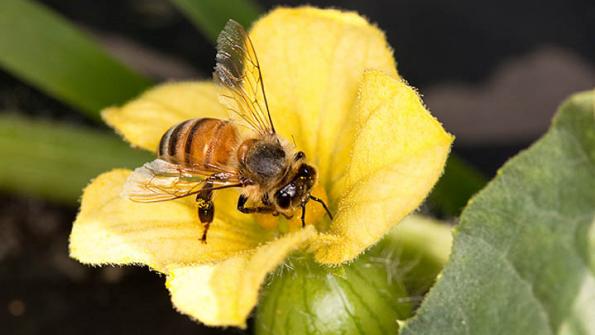June 20, 2012

Iowa State University is taking a team approach in studying what is behind the disappearance of honeybees known as "Colony Collapse Disorder."
Amy Toth, assistant professor in Iowa State's ecology, evolution and organismal biology department, was awarded an Agriculture and Food Research Initiative grant by the U.S. Department of Agriculture to explore the importance of nutritional stress and viruses on honeybee health. She is working with researchers Allen Miller and Jimena Carillo-Tripp in the plant pathology and microbiology department and Bryony Bonning in the entomology department.
"We're taking a novel approach to studying the colony collapse phenomenon," Toth said. "A lot of scientists are looking at viruses or nutrition or pesticides; our approach is the interaction among many factors and evaluating how they all work together."
Colony Collapse Disorder was recognized in 2006, but Toth said honeybees have been in trouble for decades. Beekeepers commonly experienced annual colony losses of 15 to 20 percent. In recent years however, there have been losses of 30 to 40 percent, and up to 70 percent in Iowa, forcing the beekeeping industry to take notice.
(For more, see: California beekeeper driven by passion, pollination and quality)
The effects of colony collapse are sudden. Adult worker bees, responsible for supplying food for the colony, vacate the hive and do not return leading to an "abandoned" hive containing a queen and young, but few workers to maintain the hive. This rapidly results in the colony's demise.
Fewer honeybees to pollinate food crops has led some farmers to import bees from Australia to ensure an adequate supply. The USDA reports that bee pollination is responsible for $15 billion in added crop value, particularly for specialty crops such as almonds and other nuts, berries, fruits and vegetables.
"This is a food security issue that seeks to maintain competitiveness of U.S. agriculture," she says. "If pollinating insects disappeared from the food chain, the human diet would be much less diverse."
Scientists have so far been frustrated in pointing to one cause of the disorder. Some hypotheses include landscape changes, viral diseases, nutrition and human impacts, including pesticides.
Toth and postdoctoral associate Adam Dolezal are focusing on the combination of genetics, behavior and nutrition using an experimental approach that seeks to recreate colony collapse in a lab setting. She said most previous research has been observation-based surveys of affected hives.
"Like many human diseases, colony collapse is probably caused by multiple factors," Toth said.
They suggest that bee colonies are nutritionally stressed, and this leads foragers to leave for food to satisfy the nutritional needs of the colony. When combined with viral symptoms such as seizures and paralysis, these weakened bees are unable to return to the hive.
To conduct the experiments, Iowa State researchers are working with the state apiarist, Andrew Joseph, who undertakes beekeeping inspections and outreach for the Iowa Department of Agriculture and Land Stewardship. Joseph will travel Iowa collecting bees affected by Colony Collapse Disorder.
At Iowa State, researchers will establish small experimental colonies of 3,000 bees, derived from Toth's newly established Iowa State apiary of 20 colonies. Working in a contained greenhouse, researchers will infect the bees with viruses. Some colonies will receive poor diets, while others will receive nutritionally rich and diverse diets. Toth and colleagues will then study how the health of each colony is affected and will compare bees from the research trials to those gathered in the field.
The study has implications for other insects that are pollinators, Toth said.
"It's not just bees that are sick. There are similar declines in many types of pollinators, including butterflies and moths," Toth said.
You May Also Like




